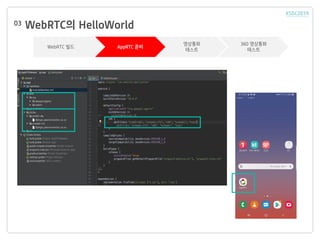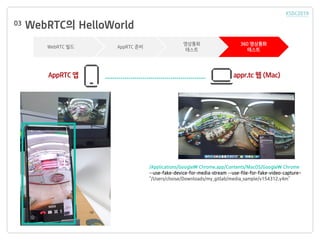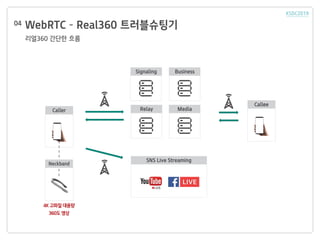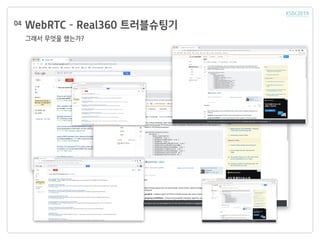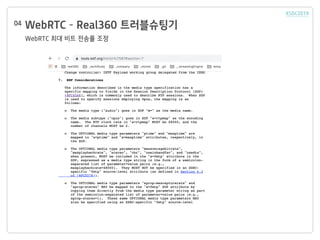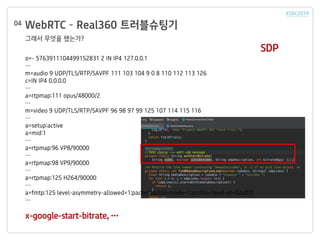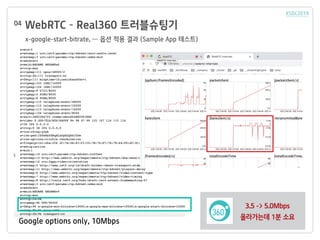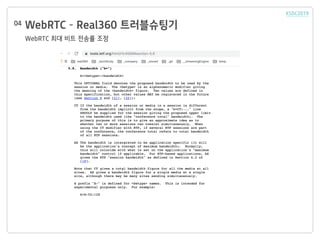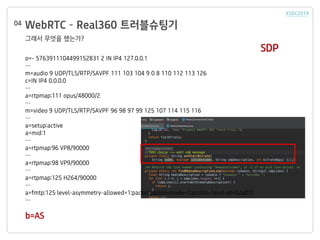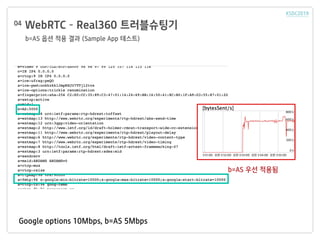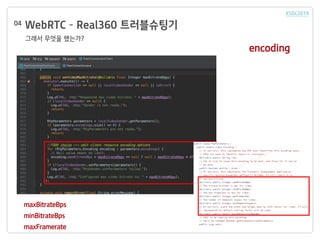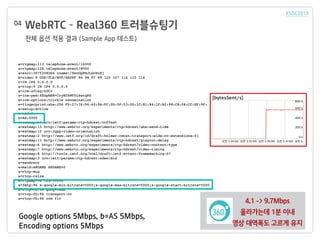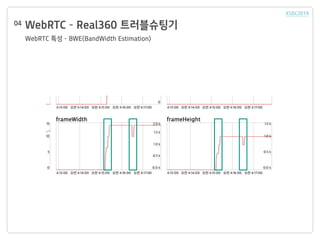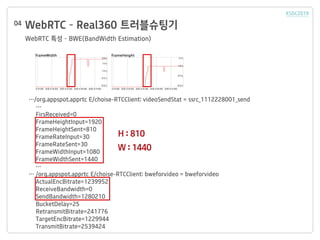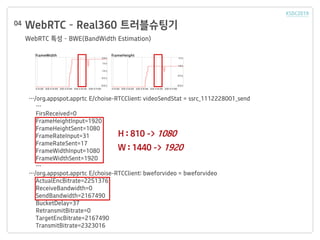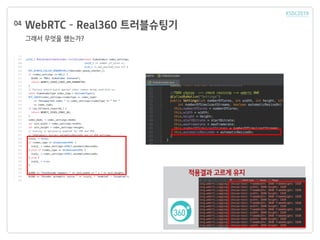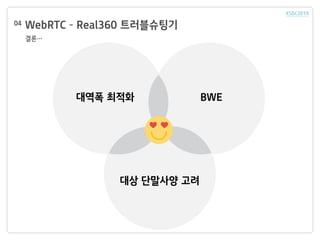????, WebRTC? ??? 360? ???? ??? ??
- 1. ????, WebRTC? ??? 360? ???? ??? ?? ???
- 2. Contents 1 WebRTC? 2 WebRTC? ??? ??? 3 WebRTC? HelloWorld 4 WebRTC ¨C Real360 ??????
- 3. (??) WebRTC ? Android Client Web Front-End ?? - UI Builder Solution - Services Common Module & Front-End Dev. - Framework Tool Eclipse Plugin Dev. KT ??? (Seuyun Choi)
- 4. Contents 1 WebRTC? 2 WebRTC? ??? ??? 3 WebRTC? HelloWorld 4 WebRTC ¨C Real360 ??????
- 5. WebRTC? ˇ°WebRTC?, Web Real-Time Communicationˇ± 01
- 7. WebRTC? Peer to Peer ?? ??? ??? ??? Alice Bob 01
- 8. WebRTC? Peer to Peer ?? ??? ??? ??? Signaling Signaling Media Alice Bob 01
- 9. WebRTC? ICE(Internet Connectivity Establishment) Candidate 01 ˇ 0, candidate: candidate:842163049 1 udp 1685987071 1.2.3.4 123 typ srflx raddr 9.8.7.6 rport 987 ˇ 0, candidate: candidate:842163049 1 udp 1685987071 1.2.3.4 123 typ srflx raddr 9.8.7.6 rport 987 ˇ 0, candidate: candidate:1239237416 1 udp 41820671 1.2.3.4 123 typ relay raddr 9.8.7.6 rport 987 ˇ 0, candidate: candidate:917939525 1 udp 25042943 1.2.3.4 123 typ relay raddr 9.8.7.6 rport 987 ˇ iceconnectionstatechange Connected ˇ 1 RTP 2 RTCP UDP TCP host : local srflx : from STUN peer prflx from STUN remote peer relay : TURN
- 10. WebRTC? Peer to Peer ?? ??? ??? ??? Alice Bob 01
- 11. WebRTC? Peer to Peer ?? ??? ??? ??? Alice 01 NAT STUN Who am I ? You are 168.x.x.x : yyyy Bob NAT 192.x.x.x : yyyy
- 12. WebRTC? Peer to Peer ?? ??? ??? ??? 01 Alice Bob TURN Relay Media 168.x.x.x : yyyy
- 14. WebRTC? WebRTC ?? API Web Android iOS getUserMedia RTCPeerConnection RTCDataChannel 01 org.webrtc.VideoCapturer org.webrtc.PeerConnection org.webrtc.RTCDataChannel RTCVideoCapturer RTCPeerConnection RTCDataChannel
- 15. WebRTC? Peer to Peer ?? ?? 01 Peer RemotePeer -- Create Peer Connection -- Set Local Description& ICE Negotiation -- Get Local Media Stream Create Peer Connection -- Set Local Description-- Add Local Media Stream -- Set Remote Description& ICE Negotiation -- Add Remote Media Stream -- -- Set Remote Description -- Add Remote Media Stream ICE Offer ICE Answer Media
- 16. Contents 1 WebRTC? 2 WebRTC? ??? ??? 3 WebRTC? HelloWorld 4 WebRTC ¨C Real360 ??????
- 17. WebRTC? ??? ???02 ??? ?? ????? ?? WebRTC?ˇ
- 18. Contents 1 WebRTC? 2 WebRTC? ??? ??? 3 WebRTC? HelloWorld 4 WebRTC ¨C Real360 ??????
- 19. WebRTC? HelloWorld WebRTC PoC ?? 03 WebRTC ?? AppRTC ?? ???? ??? 360 ???? ???
- 20. WebRTC? HelloWorld03 WebRTC ?? AppRTC ?? ???? ??? 360 ???? ??? Ubuntu + ?? 20G + ??? > webRTC? ?????? ???? ? (??: https://webrtc.org/native-code/android/) Ubuntu ?? (mac ??? virtualbox, sudo mode ??..) apt-get install git mkdir webrtc cd webrtc git clone https://chromium.googlesource.com/chromium/tools/depot_tools.git export PATH=pwd`/depot_tools:"$PATH" export GYP_DEFINES="OS=android" fetch --nohooks webrtc_android gclient sync ¨Cforce : ???? ..??? y/n ?? ???? ??? ????? ?? cd src ./build/install-build-deps.sh --no-chromeos-fonts ./build/install-build-deps-android.sh (dir src ??? ?? ??) gn gen out/Default --args='target_os="android" target_cpu="arm" is_debug=false' ninja -C out/Default AppRTCMobile ????? ??? ??? ?? ?? ??? ?? (mac ??? shared) [src]/out/Default/libjingle_peerconnection_so.so
- 21. WebRTC? HelloWorld03 WebRTC ?? AppRTC ?? ???? ??? 360 ???? ???
- 22. WebRTC? HelloWorld03 WebRTC ?? AppRTC ?? ???? ??? 360 ???? ??? AppRTC ? appr.tc ?
- 23. WebRTC? HelloWorld03 WebRTC ?? AppRTC ?? ???? ??? 360 ???? ??? AppRTC ? appr.tc ? (Mac) /Applications/Google Chrome.app/Contents/MacOS/Google Chrome --use-fake-device-for-media-stream --use-file-for-fake-video-capture= "/Users/choise/Downloads/my_gitlab/media_sample/v154312.y4m"
- 24. WebRTC? HelloWorld03 WebRTC ?? AppRTC ?? ???? ??? 360 ???? ??? IˇŻm Ready !!
- 25. Contents 1 WebRTC? 2 WebRTC? ??? ??? 3 WebRTC? HelloWorld 4 WebRTC ¨C Real360 ??????
- 26. WebRTC ¨C Real360 ?????? WebRTC? 360? 4K ???? ??? ????? 04 ??? ? ? ?? ??..
- 27. WebRTC ¨C Real360 ??????04 360 ?? ??? ?? ?? WebRTC ?? ??? ?? 2Mbps
- 28. WebRTC ¨C Real360 ?????? ??360 ??? ?? 04 SNS Live Streaming Neckband Caller Business Relay Media Callee 4K ??? ??? 360? ?? Signaling
- 29. WebRTC ¨C Real360 ?????? ??? ??? ???? 04
- 30. WebRTC ¨C Real360 ?????? WebRTC ?? ?? ??? ?? 04
- 31. WebRTC ¨C Real360 ?????? ??? ??? ???? 04 SDP o=- 5763911104499152831 2 IN IP4 127.0.0.1 ˇ m=audio 9 UDP/TLS/RTP/SAVPF 111 103 104 9 0 8 110 112 113 126 c=IN IP4 0.0.0.0 ˇ a=rtpmap:111 opus/48000/2 ˇ m=video 9 UDP/TLS/RTP/SAVPF 96 98 97 99 125 107 114 115 116 ˇ a=setup:active a=mid:1 ˇ a=rtpmap:96 VP8/90000 ˇ a=rtpmap:98 VP9/90000 ˇ a=rtpmap:125 H264/90000 ˇ a=fmtp:125 level-asymmetry-allowed=1;packetization-mode=1;profile-level-id=42e01f ˇ x-google-start-bitrate, ˇ
- 32. WebRTC ¨C Real360 ?????? x-google-start-bitrate, ˇ ?? ?? ?? (Sample App ???) 04 3.5 -> 5.0Mbps ????? 1? ?? Google options only, 10Mbps
- 33. WebRTC ¨C Real360 ?????? WebRTC ?? ?? ??? ?? 04
- 34. WebRTC ¨C Real360 ?????? ??? ??? ???? 04 SDP o=- 5763911104499152831 2 IN IP4 127.0.0.1 ˇ m=audio 9 UDP/TLS/RTP/SAVPF 111 103 104 9 0 8 110 112 113 126 c=IN IP4 0.0.0.0 ˇ a=rtpmap:111 opus/48000/2 ˇ m=video 9 UDP/TLS/RTP/SAVPF 96 98 97 99 125 107 114 115 116 ˇ a=setup:active a=mid:1 ˇ a=rtpmap:96 VP8/90000 ˇ a=rtpmap:98 VP9/90000 ˇ a=rtpmap:125 H264/90000 ˇ a=fmtp:125 level-asymmetry-allowed=1;packetization-mode=1;profile-level-id=42e01f ˇ b=AS
- 35. WebRTC ¨C Real360 ?????? b=AS ?? ?? ?? (Sample App ???) 04 b=AS ?? ??? Google options 10Mbps, b=AS 5Mbps
- 36. WebRTC ¨C Real360 ?????? b=AS ?? ?? ?? (Sample App ???) 04 Google options 5Mbps, b=AS 5Mbps 3.6 -> 9.6Mbps ????? 1? ?? ??? ??? ??
- 37. WebRTC ¨C Real360 ?????? ??? ??? ???? 04 encoding maxBitrateBps minBitrateBps maxFramerate
- 38. WebRTC ¨C Real360 ?????? ?? ?? ?? ?? (Sample App ???) 04 Google options 5Mbps, b=AS 5Mbps, Encoding options 5Mbps 4.1 -> 9.7Mbps ????? 1? ?? ?? ???? ??? ??
- 39. WebRTC ¨C Real360 ?????? WebRTC ?? ¨C BWE(BandWidth Estimation) 04
- 40. WebRTC ¨C Real360 ?????? WebRTC ?? ¨C BWE(BandWidth Estimation) 04 ˇ/org.appspot.apprtc E/choise-RTCClient: videoSendStat = ssrc_1112228001_send ˇ FirsReceived=0 FrameHeightInput=1920 FrameHeightSent=810 FrameRateInput=30 FrameRateSent=30 FrameWidthInput=1080 FrameWidthSent=1440 ˇ ˇ /org.appspot.apprtc E/choise-RTCClient: bweforvideo = bweforvideo ActualEncBitrate=1239952 ReceiveBandwidth=0 SendBandwidth=1280210 BucketDelay=25 RetransmitBitrate=241776 TargetEncBitrate=1229944 TransmitBitrate=2539424 H : 810 W : 1440
- 41. WebRTC ¨C Real360 ?????? WebRTC ?? ¨C BWE(BandWidth Estimation) 04 ˇ/org.appspot.apprtc E/choise-RTCClient: videoSendStat = ssrc_1112228001_send ˇ FirsReceived=0 FrameHeightInput=1920 FrameHeightSent=1080 FrameRateInput=31 FrameRateSent=17 FrameWidthInput=1080 FrameWidthSent=1920 ˇ ˇ/org.appspot.apprtc E/choise-RTCClient: bweforvideo = bweforvideo ActualEncBitrate=2251376 ReceiveBandwidth=0 SendBandwidth=2167490 BucketDelay=37 RetransmitBitrate=0 TargetEncBitrate=2167490 TransmitBitrate=2323016 H : 810 -> 1080 W : 1440 -> 1920
- 42. WebRTC ¨C Real360 ?????? ??? ??? ???? 04 ???? ??? ??
- 43. WebRTC ¨C Real360 ?????? ??ˇ 04 ??? ??? BWE ?? ???? ??
- 44. WebRTC ¨C Real360 ???? ? ?? ????ˇ 04 Codecs Platform Web Peer ˇ Services
- 45. QnA
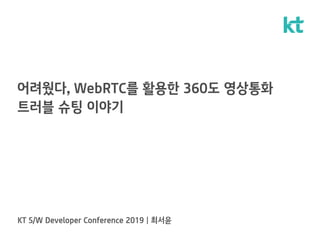
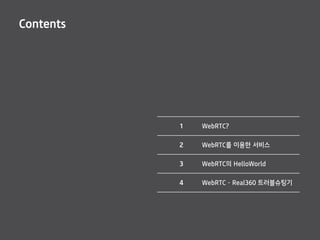
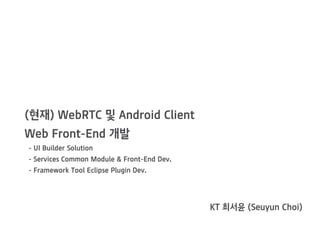
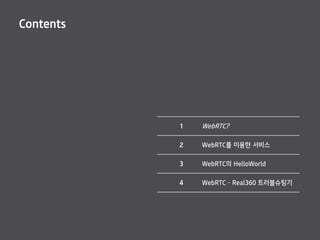
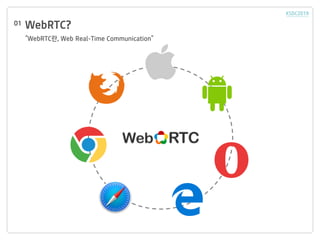
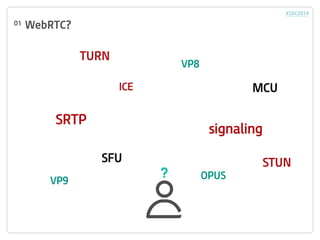


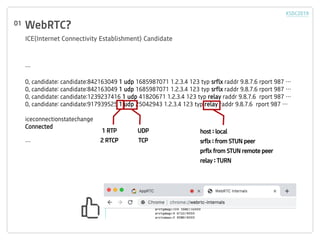

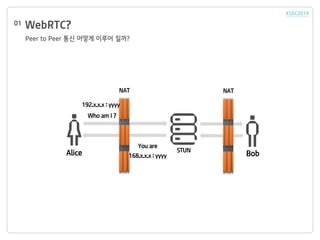
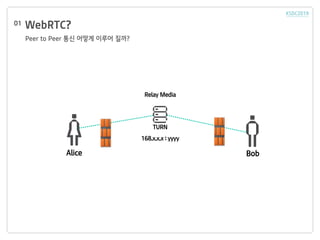

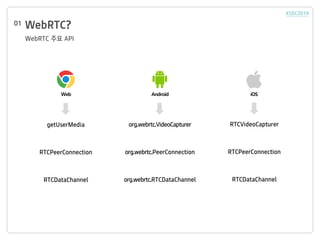
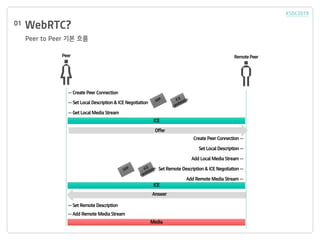
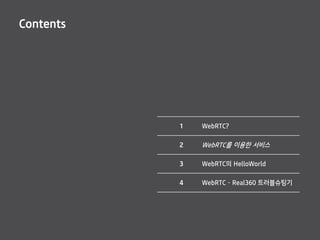

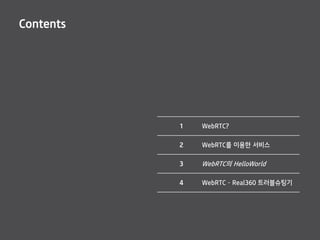
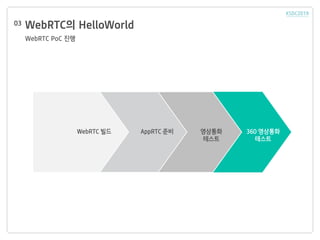
![WebRTC? HelloWorld03
WebRTC ?? AppRTC ??
????
???
360 ????
???
Ubuntu + ?? 20G + ???
> webRTC? ?????? ???? ? (??: https://webrtc.org/native-code/android/)
Ubuntu ?? (mac ??? virtualbox, sudo mode ??..)
apt-get install git
mkdir webrtc
cd webrtc
git clone https://chromium.googlesource.com/chromium/tools/depot_tools.git
export PATH=pwd`/depot_tools:"$PATH"
export GYP_DEFINES="OS=android"
fetch --nohooks webrtc_android
gclient sync ¨Cforce : ???? ..??? y/n ??
???? ??? ????? ??
cd src
./build/install-build-deps.sh --no-chromeos-fonts
./build/install-build-deps-android.sh
(dir src ??? ?? ??)
gn gen out/Default --args='target_os="android" target_cpu="arm" is_debug=false'
ninja -C out/Default AppRTCMobile
????? ??? ??? ?? ?? ??? ?? (mac ??? shared)
[src]/out/Default/libjingle_peerconnection_so.so](https://image.slidesharecdn.com/webrtctroubleshooting-190830015311/85/WebRTC-360-20-320.jpg)
